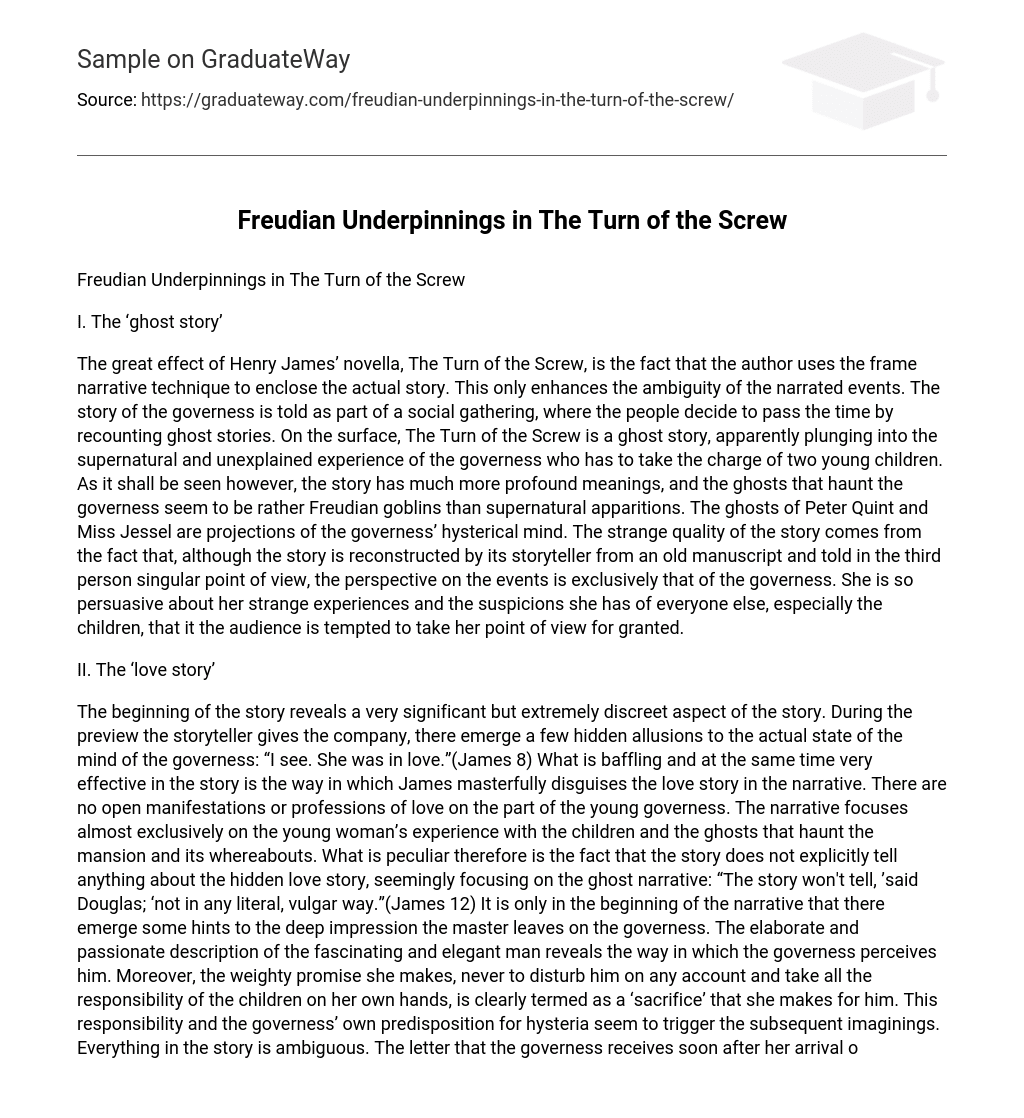I. The ‘ghost story’
The great effect of Henry James’ novella, The Turn of the Screw, is the fact that the author uses the frame narrative technique to enclose the actual story. This only enhances the ambiguity of the narrated events. The story of the governess is told as part of a social gathering, where the people decide to pass the time by recounting ghost stories. On the surface, The Turn of the Screw is a ghost story, apparently plunging into the supernatural and unexplained experience of the governess who has to take the charge of two young children. As it shall be seen however, the story has much more profound meanings, and the ghosts that haunt the governess seem to be rather Freudian goblins than supernatural apparitions. The ghosts of Peter Quint and Miss Jessel are projections of the governess’ hysterical mind. The strange quality of the story comes from the fact that, although the story is reconstructed by its storyteller from an old manuscript and told in the third person singular point of view, the perspective on the events is exclusively that of the governess. She is so persuasive about her strange experiences and the suspicions she has of everyone else, especially the children, that it the audience is tempted to take her point of view for granted.
II. The ‘love story’
The beginning of the story reveals a very significant but extremely discreet aspect of the story. During the preview the storyteller gives the company, there emerge a few hidden allusions to the actual state of the mind of the governess: “I see. She was in love.”(James 8) What is baffling and at the same time very effective in the story is the way in which James masterfully disguises the love story in the narrative. There are no open manifestations or professions of love on the part of the young governess. The narrative focuses almost exclusively on the young woman’s experience with the children and the ghosts that haunt the mansion and its whereabouts. What is peculiar therefore is the fact that the story does not explicitly tell anything about the hidden love story, seemingly focusing on the ghost narrative: “The story won’t tell, ’said Douglas; ‘not in any literal, vulgar way.”(James 12) It is only in the beginning of the narrative that there emerge some hints to the deep impression the master leaves on the governess. The elaborate and passionate description of the fascinating and elegant man reveals the way in which the governess perceives him. Moreover, the weighty promise she makes, never to disturb him on any account and take all the responsibility of the children on her own hands, is clearly termed as a ‘sacrifice’ that she makes for him. This responsibility and the governess’ own predisposition for hysteria seem to trigger the subsequent imaginings. Everything in the story is ambiguous. The letter that the governess receives soon after her arrival on the premises and which announces the boy’s permanent dismissal from school is the first step in this direction. The pressure on the governess becomes immense. From this perspective, the story can be interpreted as emerging from the repressed and brooding love that the governess has for the master she only sees twice in her life. But the events take such a strange turn that it becomes unclear whether the focus of the governess’ love is actually the figure of the master: “Oh, he did, ’Mrs. Grose assented – ‘it was the way he liked everyone!’ She had no sooner spoken indeed than she caught herself up. ‘I mean that’s his way — the master’s’ I was struck. ‘But of whom did you speak first?’ She looked blank, but she colored. ‘Why, of him.’(James 33) There are obvious allusions throughout the story to the peculiar relationship she has with Miles, the young boy. The letter which gives her the first warning is one such instance. The ambiguous end where the two of them are left alone and the boy dies in her arms is another strange scene. The male figure that triggers the disturbance in the governess’ mind is not clearly defined.
III. The neurotic mind
All the elements in the story point to one essential idea: the Turn of the Screw is a masterful glimpse of a highly neurotic mind. The ambiguities of every event and of every character are translated as the inability of the neurotic to reason clearly. The neurotic mind is haunted by suspicions, presuppositions and subjective interpretations. In the beginning, the author alludes to the governess delicate balance of mind: “She was young, untried, nervous: it was a vision of serious duties and little company, of really great loneliness.”(James 15) The governess constantly interprets everything around her and the reactions she sees in other people in a subjective way. She suspects the children of being able to see the ghosts and hide this truth from her. The scenes where she places herself in the same seats where the she sees the ghosts are probably the most peculiar and representative. She seems thus to look back on her own mind and on herself as seeing the strange reflections and projections.
Questions for discussion:
What is it that actually happens at the end of the novella? How can Miles’ mysterious death be explained?
What makes the governess perceive Miles as being possessed by the ghost of Quint? Is there a parallelism between the two ghosts, a man and a woman, and the two children? Why does the governess seemingly fight with the ghost of Peter Quint over the soul of the boy in the end?
References:
Babbage, Frances. “The play of surface: theater and The Turn of the Screw.” Comparative Drama 39.2 (Summer 2005): 131(26).
James, Henry. (1991) The Turn of the Screw. New York: Dover.
Nikolopoulou, Kalliopi. “Autospectrography: On Henry James’s The Turn of the Screw.” Journal of Modern Literature 28.1 (Fall 2004): 1(24).
;





